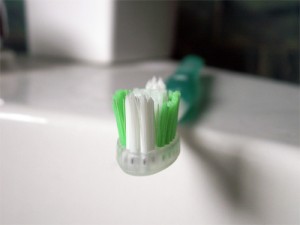 We all care about our winning smile, and strong healthy teeth, so how can we keep up the kind of great dental hygiene and care we’ve all become accustomed to if total economic collapse, terrorism, or a super EMP from a solar burst sends us reeling back into the pre-industrial world of the 1850s? As it turns out, good dental hygiene doesn’t require a multi-billion dollar industry in a shiny 21st century package. There are plenty of ways that you can start saving money right now with inexpensive and natural approaches to health teeth, breath, and gums.
We all care about our winning smile, and strong healthy teeth, so how can we keep up the kind of great dental hygiene and care we’ve all become accustomed to if total economic collapse, terrorism, or a super EMP from a solar burst sends us reeling back into the pre-industrial world of the 1850s? As it turns out, good dental hygiene doesn’t require a multi-billion dollar industry in a shiny 21st century package. There are plenty of ways that you can start saving money right now with inexpensive and natural approaches to health teeth, breath, and gums.
Toothpaste
Your dentist has always told you that the brush is more important than the toothpaste. The number one purpose for brushing your teeth is to remove the plaque that can lead to tooth decay. That’s the brush’s job. The paste adds some nice extras like whitening your teeth and freshening your breath. Well, there’s no simple replacement for a good toothbrush, but you might want to try one of these easy recipes for homemade toothpaste.
Just dipping your wet brush into plain baking soda is a decent alternative to toothpaste all by itself. Baking soda is a fine abrasive that is easy on tooth enamel but still helps to remove plaque and tartar. Try adding a pinch of salt to about three teaspoons of the soda if you need a little more abrasion. If you want a real paste instead of a simple tooth powder, you can add two teaspoons of glycerin (which is available at any health food store) to the mixture.
Perhaps you’ve been spoiled by the modern miracles of whiteners and protection from gingivitis. No problem! Add a few drops (or so) of hydrogen peroxide to your paste. The oxygenating action of the baking soda is already giving you some whitening benefit, but the hydrogen peroxide will enhance the whitening power and add germ-fighting protection too. A few drops of peppermint oil (the edible kind from the baking section near the vanilla extract, not the kind for scenting paper or burning for aromatherapy!) can give you that familiar minty taste and freshen your breath too. Some people like to use a drop of a citrus extract like orange or lemon instead. If you prefer a more natural ingredient, you can pulverize real orange peel zest in a mortar and pestle and add a spoonful to your paste.
You can add more antiseptic germ-killing properties to your concoction, plus a little more whitening power, by adding a modicum of powdered sage. Folksy, tasty, natural, and effective—all for a fraction of the cost of commercial toothpastes.
Mouthwash
Alcohol-based mouthwashes rule the market place right now, and are effective in killing germs and freshening breath for healthy teeth and gums. One bottle of vodka will make four bottles of mouthwash, when blended with three parts of distilled water. No fancy, high-end designer vodka is required here; just the cheapest bottle with a good alcohol content. Those are the only two essential ingredients: vodka and distilled water. Just swirl, gargle, or pucker it around in your mouth for at least thirty seconds, spit and rinse. Germs and bacteria are gone. Add a few drops of a citrus extract or peppermint oil to each bottle for better taste and fresher breath if you like.
Alcohol-based mouthwashes are not for everybody. Alcohol has the effect of making the mouth and gums very dry and sensitive for some people. You may recall experiencing “cotton mouth” back in your college days a few times after an extended visit with your frat buddies. Alcohol can also aggravate tooth sensitivity. And, of course, many people are not crazy about the idea of giving their kids a mouthful of vodka. For these situations, try a cup of distilled water with mint or parsley. All varieties of mint leaves will kill the germs that cause bad breath, and freshen your mouth too. The best technique is to puree the fresh mint leaves or parsley and add the strained liquid to your distilled water.
A teaspoon of salt works well to add disinfecting properties to your cup of water as well, if you don’t mind the taste. Or, you can try adding natural floral ingredients. Add a couple tablespoons of lavender leaves or rose petals to a cup of boiling water, and then let it steep for a few hours. Strain it and bottle it. Be sure to cap the bottle to keep the natural ingredients from deteriorating in the open air. You can add vodka to any of these herbal or floral brews as well for a flavored or “kicked up” version of your alcohol-based mouthwash.
The other basic elements of good oral health remain the same. Brush at least twice a day with a soft-bristled brush – after every meal is better. Don’t forget to brush your tongue, which captures a lot of food particles and odors that cause bad breath. Take it easy on the coffee, tea, soda, and cigarettes that discolor your teeth and weaken your enamel. You can save money and still have great oral hygiene with the same good practices you use now, together with these simple, natural, and self-sufficient products you can make at home.
 Off The Grid News Better Ideas For Off The Grid Living
Off The Grid News Better Ideas For Off The Grid Living



